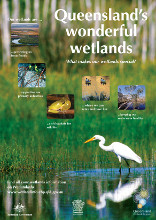|
|
WetlandInfo—your first-stop-shop for wetland management resources in QueenslandSelect the area type
WetlandSummary—facts and mapsFind wetland information for regions of Queensland. WetlandSummary provides:
World Wetlands Day February 2025Read the full newsletter (with pages links) or subscribe. World Wetlands Day is celebrated on 2 February each year. It marks the anniversary of the signing of the Convention on Wetlands of International Importance in the Iranian city of Ramsar in 1971. The convention now has a global membership of over 170 countries and the day represents a global awareness campaign to highlight the value of wetlands. Find more information on World Wetlands Day in Queensland here. FactsheetsUpdated pages and toolsBowling Green Bay Ramsar Information Sheet
WetlandMaps and WetlandSummary
Assessment Toolbox Methods
Wetland projects search tool
Additional links
We value your input and feedback so please email us your comments, wetland information and links or that wetland question you just can't answer. Wonderful wetlandsWetlands are important for our environment, economy and our livelihoods. They have many functions from reducing floods to producing clean water and food for humans, industry and agriculture. They provide important habitat for many animals and plants. Wetlands are the great ‘connectors’ across our landscape providing places for our enjoyment and relaxation. Regardless of whether you are doing a school or uni assignment, managing a wetland or undertaking research, you will find a wealth of information here on WetlandInfo. Read more… WetlandInfo feature speciesWorldwide, there are four species of mud crab, two of which are found in Queensland waters – Scylla serrata, the Giant Mud Crab and Scylla olivacea, the Orange Mud Crab, the latter being less common, except for the northern Gulf of Carpentaria and occasionally on the east coast as far south as Townsville. The giant mud crab is an ecologically important species of crab found in mangrove lined rivers, sheltered estuaries and tidal flats. Juvenile mud crabs are found in the mangrove zone and subadult and adults migrate into the intertidal zone to feed at high tide. Their shells can vary in colour, ranging from blue to a deep mottled green and very dark brown. Giant mud crabs can grow up to 300 millimetres in shell width, and weigh up to 2.5 kilograms. Mud crabs have large claws, and their last pair of legs are flattened for swimming. Crabs grow through a series of moults as they reach the size of their current shell. Mud crabs will use their claws for defence and sometimes shed their claws to escape. Starting as zoea (type of larva), mud crabs hatch from eggs and float in the water. The zoea will then moult four times over a period of 12 to 15 days (temperature dependent), becoming a megalopa on the fifth moult, with functioning claws. Soon after the megalopa metamorphoses to becomes a crablet about 3 mm in shell width. Mud crabs moult multiple times through their life to grow (about 16 moults) reaching sexual maturity at 18 to 24 months old. Females can produce up to three egg-masses, with 34 to 59 days between spawning events under aquaculture conditions. The fertilised eggs are released in batches of two to five million. Once hatched, the pelagic larvae are distributed by ocean currents, but eventually must reach nearshore waters to survive and metamorphose into megalopa. There is high larval mortality, hence the large number of eggs produced by mud crabs. Mud crabs forage at night and eat slow moving or stationary animals such as molluscs, smaller crabs and worms. Mud crabs use their large claw to crush and their smaller claw to cut. Their claws are very powerful - mud crabs can crush shells that require up to 40 kilograms of force to break! Additional information |

 — Department of the Environment, Tourism, Science and Innovation
— Department of the Environment, Tourism, Science and Innovation




